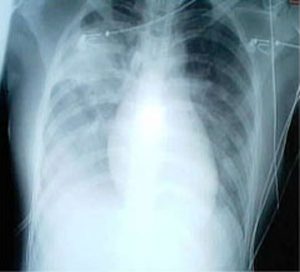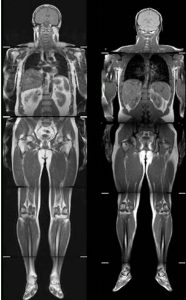3.3 Ideal Body Weight
What is Ideal Body Weight (IBW)? Essentially, every body has a set weight that reflects the size of their vital organs, based on their sex and height. IBW is not about a number on a scale or body morphology; it is a unit of measurement that is used to describe the organs in the body. Do not get caught up in the “weight” term—we use IBW to ventilate properly based on the size of the patient’s lungs.
Historically, clinicians used to ventilate with large volumes [latex](\text{>600 mL})[/latex] and slow [latex]RR\;(10\text{ - }12\text{ bpm})[/latex]. This style of ventilation resulted in significant number of patients developing lung damage after mechanical ventilation for a few days. This damage was referred to as Ventilator Induced Lung Injury (VILI), and it sometimes resulted in an inflammatory process often referred to as Acute Respiratory Distress Syndrome (ARDS).

ARDS is a complex pathology that is recognized as diffuse bilaterally inflammation and damage to the lungs. It is usually identified on a chest x-ray after other pathophysiologies are ruled out. It can be caused by other processes in addition to VILI. These patients can become very sick and difficult to ventilate. If you would like some basic knowledge regarding ARDS, refer to these two links for a brief overview (the first link is more basic, and the second link provides more advanced information):
- ARDS (Mayo Clinic)
- Acute Respiratory Distress Syndrome: New Definition, Current and Future Therapeutic Options
ARDS ventilation will be discussed in detail in a later chapter.
When it was identified that mechanical ventilation was seeming to cause bilateral damage to the lungs, multiple studies were carried out to determine if the settings on the ventilator were contributing to this. The conclusions were very clear that using large tidal volumes directly related to increased incidence of VILI by causing barotrauma (too much pressure in the alveoli) and volutrauma (too much volume in the alveoli).
Object Lesson
A weight-based approach to choosing tidal volumes started to be used. The smaller the patient, the smaller the tidal volumes and the larger the patient, the larger the tidal volumes. It was still common practice to assume patients with a higher weight required a larger volume to satisfy their ventilation needs (O2 in and CO2 out) because they had more habitus, meaning more cells in the body creating CO2 and needing oxygen to function. After bariatric patients were getting VILI at a higher incidence when the larger tidal volumes were used, further investigation revealed that the size of the lungs do not alter based on body weight of the patient. A person’s lung size is based on skeletal structure, which means the only relevant variables are sex and height. By ventilating heavier patients with larger volumes, clinicians were overinflating the alveoli in the lungs and causing barotrauma and volutrauma, leading to VILI.
Fun fact: If you see a full body CT scan or MRI of a bariatric patient, this concept is clear. Regardless of body habitus, a bariatric patient’s lungs are not larger than another patient that is the same sex and height. The size of the lungs does not change based on the body weight of the patient.

To fix this problem once and for all, ventilation is now completely based on Ideal Body Weight (IBW). IBW is calculated based on a patient’s sex and height to ensure the weight used to estimate the tidal volumes is correct based on what the patient should be getting. When setting up a ventilator for an adult patient, the only calculation you will have to do is determine their ideal body weight and then use that weight to choose a safe tidal volume for your patient.
Then, IBW depends on the sex of the patient. Here are the formulas for males and females:
|
Sex |
IBW Formula (Adults Only) |
|---|---|
| Male | [latex]\small{\text{IBW (Kg)}=106+6\;(\text{Height (in.)}-60)}[/latex] |
| Female | [latex]\small{\text{IBW (Kg)}=105+5\;(\text{Height (in.)}-60)}[/latex] [latex]\small{*\left(\frac{\text{lbs}}{2.2}=\text{Kg}\right)}[/latex] |
Important note: For an adult patient, the minimum ideal body weight (Kg) you will use is the constant at the beginning of the equation. If you end up with a zero or negative number in the bracket, do not continue with this formula: just use [latex]50\text{ Kg}[/latex] for males or [latex]45.5\text{ Kg}[/latex] for females—which are the minimum sizes for adult lungs.
For a more detailed demonstration on how to calculate ideal body weight, please watch this video, which uses pounds.
Examples
Let’s do a couple of calculations together!
Patient A | A male who is 6’2” (74 inches tall)
[latex]\begin{align*}\text{IBW (lbs)}&=106+6(74-60)\\\text{IBW (lbs)}&=106+6(14)\\\text{IBW (lbs)}&=106+84\\\text{IBW (lbs)}&=190\text{ lbs}\\\text{IBW (Kg)}&=\frac{190\text{ lbs}}{2.2\text{ Kg/lb}}=86\text{ Kg}\end{align*}[/latex]
Patient B | A female who is 5’3”
[latex]\begin{align*}\text{IBW (lbs)}&=105+5(63-60)\\\text{IBW (lbs)}&=105+5(3)\\\text{IBW (lbs)}&=105+15\\\text{IBW (lbs)}&=120\text{ lbs}\\\text{IBW (Kg)}&=\frac{120\text{ lbs}}{2.2\text{ Kg/lb}}=55\text{ Kg}\end{align*}[/latex]
Even with the determination of using the ideal body weight instead of actual body weight, historically, tidal volumes of [latex]10\text{ mL}[/latex] for every kilogram of IBW were often used. This approach still resulted in volutrauma and VILI. In the early 2000s, many studies were done to find the best tidal volume range based on ideal body weight to decrease the risk of VILI and ARDS. Researchers also studied patients diagnosed with ARDS to see if the amount of tidal volume impacted morbidity and mortality. The results were conclusive that using tidal volumes of [latex]6\text{ - }8\text{ mL/Kg}[/latex] of ideal body weight directly improved morbidity and mortality. This discovery revolutionized tidal volume strategies and has become the gold standard of adult tidal volume ranges to decrease the risk of VILI from volutrauma/barotrauma. Today, [latex]8\text{ mL/Kg}[/latex] is the hard limit for tidal volumes to be set by clinicians in control modes. Once the IBW is calculated, it is multiplied by 6 and then 8 to get the range of safe tidal volumes for a patient on a mechanical ventilator.
Calculating Tidal Volume Range
Let’s review the steps to determine a safe tidal volume for your patients.
- Determine your patient’s height and sex.
- Use appropriate IBW formula (male versus female) to calculate your IBW.
- Multiply your [latex]6[/latex], [latex]7[/latex] and [latex]8\text{ mL/Kg}[/latex] and write these in your chart, so you have a handy reference point for the tidal volumes you can use now and in the future.
Examples
We have already learned how to calculate IBW (steps 1 and 2), so let’s try step 3 using the IBWs that were calculated earlier in this chapter. Remember, the safe range for tidal volumes is [latex]6\text{ - }8\text{ mL/Kg}[/latex].
Patient A | IBW 82.2 Kg
[latex]\begin{align*}\text{Tidal volume of 6 mL/Kg}&=86\text{ Kg}\times 6\text{ mL/Kg}\\&=516\text{ mL}\end{align*}[/latex]
[latex]\begin{align*}\text{Tidal volume of 7 mL/Kg}&=86\text{ Kg}\times 7\text{ mL/Kg}\\&=602\text{ mL}\end{align*}[/latex]
[latex]\begin{align*}\text{Tidal volume of 8 mL/Kg}&=86\text{ Kg}\times 8\text{ mL/Kg}\\&=688\text{ mL}\end{align*}[/latex]
Therefore, the safe range of ventilation is [latex]516\text{ - }688\text{ mL }(6\text{ - }8\text{ mL/Kg})[/latex] and the respective tidal volumes for [latex]6[/latex], [latex]7[/latex] and [latex]8\text{ mL/Kg}[/latex] are [latex]516[/latex], [latex]602[/latex] and [latex]688\text{ mL}[/latex] respectively.
Patient B | IBW 55 Kg
[latex]\begin{align*}\text{Tidal volume of 6 mL/Kg}&=55\text{ Kg}\times 6\text{ mL/Kg}\\&=330\text{ mL}\end{align*}[/latex]
[latex]\begin{align*}\text{Tidal volume of 7 mL/Kg}&=55\text{ Kg}\times 7\text{ mL/Kg}\\&=385\text{ mL}\end{align*}[/latex]
[latex]\begin{align*}\text{Tidal volume of 8 mL/Kg}&=55\text{ Kg}\times 8\text{ mL/Kg}\\&=440\text{ mL}\end{align*}[/latex]
The safe range of ventilation for this patient is [latex]330\text{ - }440\text{ mL}[/latex] and the respective tidal volumes for [latex]6[/latex], [latex]7[/latex] and [latex]8\text{ mL/Kg}[/latex] are [latex]330[/latex], [latex]385[/latex] and [latex]440\text{ mL}[/latex] respectively.
Key Takeaway
When patients have very fragile and damaged lungs, some ventilation strategies will go as low as [latex]4\text{ mL/Kg}[/latex] to decrease the risk of barotrauma/volutrauma.
Take this information with you, as we now split to both volume control and pressure control for their individual settings.
"Ideal Body Weight" and "IBW and the Relationship to Tidal Volume" from Basic Principles of Mechanical Ventilation by Melody Bishop, © Sault College are licensed under a Creative Commons Attribution-NonCommercial-ShareAlike 4.0 International License, except where otherwise noted.

